Gold glimmers in a river of shit | Paris 2024 Olympic skateboarding primer
Contenders, wildcards, predictions, moral failings, and more.
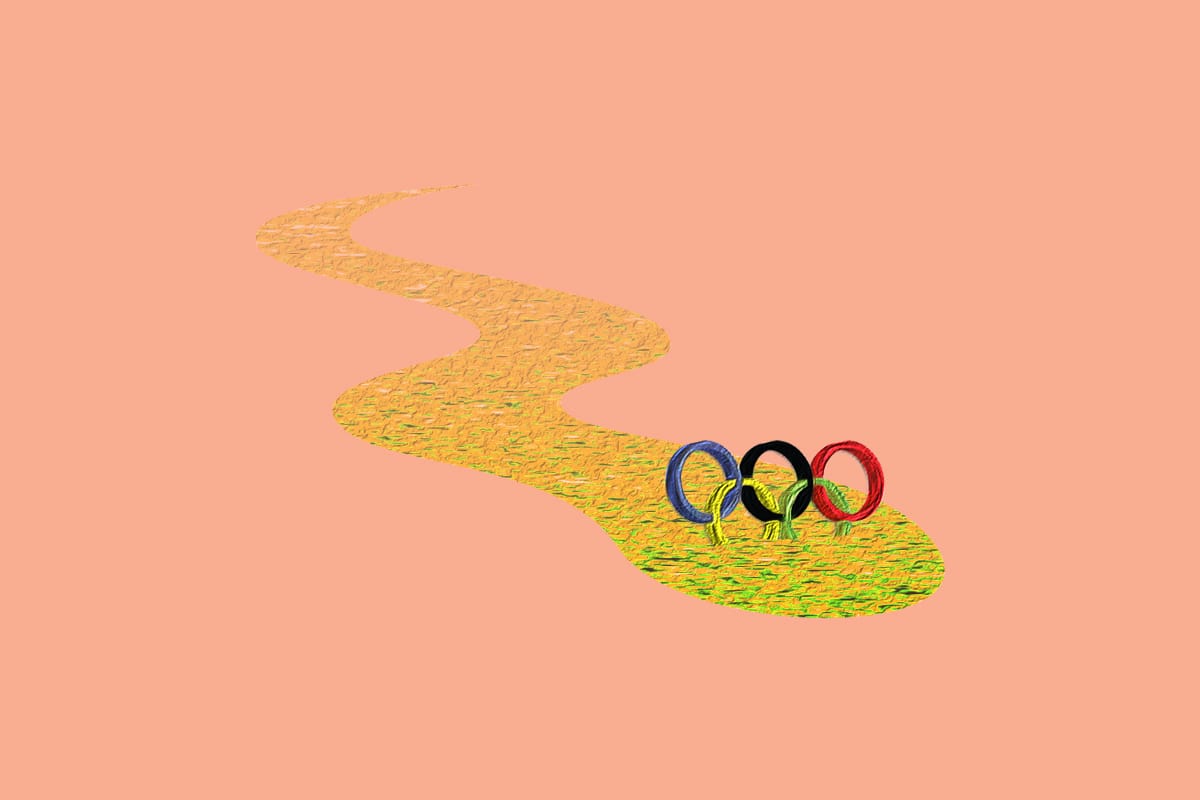
The definitive weekly ranking and analysis of all the Olympic skateboarding-related stuff that I cannot stop consuming and how it makes me feel, personally.

Olympic skateboarding primer: part 1
Rank: 🥇
Mood: 🛶
Wow, it's here: the Paris 2024 Olympic Games. The pinnacle of sport. A showcase of the world's most skilled athletes. Around 10,500 of them from 206 different nations will compete across 32 sports for about two weeks. However, for our purposes here in this newsletter, there's only one sport that matters: canoe sprinting. Just look at these beautiful bastards go.
Outside of God's Favourite Water-Based Activity, Olympic skateboarding is also on the docket in its sophomore appearance at the Games. There are two events, skateboard street and park. Yes, those names are a bit confusing, as "street" takes place in a park and "park" is in a bowl, but I'm sure World Skate and the International Olympic Committee know what they're doing.
It all starts tomorrow, July 27, when we'll see the men's street prelims in the morning and finals in the evening. On July 28, it's women's street prelims and finals. Then, on August 6, women's park prelims and finals take place, with the men's going down the following day.
A total of 88 qualified skateboarders are set to compete in Paris. Let's take a look at who they are, how we got here, and make some bold, potentially baseless predictions about who is making the podium and why, starting with skateboard street.

1. Ginwoo Onodera (JPN)
2. Sora Shirai (JPN)
3. Yuto Horigome (JPN)
4. Jagger Eaton (USA)
5. Nyjah Huston (USA)
6. Gustavo Ribeiro (POR)
7. Chris Joslin (USA)
8. Richard Tury (SVK)
9. Matias Dell Olio (ARG)
10. Aurelien Girard (FRA)
11. Kelvin Hoefler (BRA)
12. Giovanni Vianna (BRA)
13. Cordano Russell (CAN)
14. Matt Berger (CAN)
15. Ryan Decenzo (CAN)
16. Joseph Garbaccio (FRA)
17. Felipe Gustavo (BRA)
18. Vincent Milou (FRA)
19. Jhancarlos Gonzalez Ortiz (COL)
20. Mauro Iglesias (ARG)
21. Shane O'Neill (AUS)
22. Brandon Valjalo (RSA)
There are a tonne of interesting storylines going into men's street this year. Can Tokyo 2020 gold medalist Yuto Horigome retain his throne? Will Nyjah Huston shit the bed again? Is it finally time for 38-year-old Ryan Decenzo to rise to the top and bring it home for the olds? (those of us in our mid-to-late 30s). What about top-ranked child Ginwoo Onodera? Will he double-varial-flip his way onto the podium? Can French competitors Vincent Milou and Aurelien Giraud show out for their home and hosting country? So many questions.
🥇 Yuto Horigome (JPN)
🥈 Ginwoo Onodera (JPN)
🥉 Ryan Decenzo (CAN)
Despite his consistent and dramatic ability to come in clutch, it feels like people are still sleeping on reigning champ Yuto Horigome. Oddsmakers have him at 11/2 odds to take gold, with Onodera, Shirai, and Huston favoured above him. We'll see what happens tomorrow, but for my money, Horigome claims what's his, with Onodera on his heels, and feel-good longshot Decenzo capturing bronze. There's no convincing evidence the Whiterock, British Columbia, legend can do it, but just imagine the moment — a Red Dragon on the Olympic Podium! Beautiful.
Special trick prediction: Horigome lands a nollie-backside-270-heelflip-noseslide on a bump-to-ledge.
Special performance prediction: Giraud misses the podium by half a point.
In my annual "Betting on the future of skateboarding" article, I predicted that Cordano Russell would win bronze for Canada and that Vincent Milou would find inspiration in his countrymen and take gold. While I don't think either will happen now, I'm going to note them again here, just in case...

1. Coco Yoshizawa (JPN)
2. Liz Akama (JPN)
3. Rayssa Leal (BRA)
4. Funa Nakayama (JPN)
5. Chloe Covell (AUS)
6. Chenxi Cui (CHN)
7. Paige Heyn (USA)
8. Poe Pinson (USA)
9. Wenhui Zeng (CHN)
10. Yuanling Zhu (CHN)
11. Roos Zwetsloot (NED)
12. Pamela Rosa (BRA)
13. Jazmín Alvarez (COL)
14. Natalia Muñoz (ESP)
15. Liv Lovelace (AUS)
16. Keet Oldenbeuving (NED)
17. Gabi Mazetto (BRA)
18. Vareeraya Sukasem (THA)
19. Mariah Duran (USA)
20. Haylie Powell (AUS)
21. Lucie Schoonheere (FRA)
22. Boipelo Awuah (RSA)
To me, there are two things that make women's street so compelling: the parity in skill and how quickly the athletes progress from event to event. Since the 2020 Games, we've seen known names and up-and-comers advance in ability at an astonishing rate.
Fan-favourite Rayssa Leal is a shoo-in to improve upon her silver medal earned in Tokyo. Chloe Covell had an incredible year of competitive results. Then there are athletes like Coco Yoshizawa, who burst onto the scene just two years ago and now finds herself ranked number 1 heading into Paris.
While exciting and great overall entertainment, that volatility makes it tricky to predict who will come out on top.
🥇 Liz Akama (JPN)
🥈 Chloe Covell (AUS)
🥉 Rayssa Leal (BRA)
Remember when I said this would be a tricky event to predict and then mentioned a few contenders? I didn't even bring up Liz Akama, who I think has all the tools to take the top spot.
Special trick prediction: Chloe Covell does a nosegrind-nollie-kickflip down a rail.
Special performance prediction: Paige Heyn doesn't medal but puts on a gutsy and compelling performance that makes her a star inside and outside the bubble.
Poe Pinson is back on the scene after recovering from an injury. The new There Skateboards rider is creative, fearless, and consistent. I would not be surprised in the slightest if she made the top 10 or higher.
That's right, the trenchant Olympic skateboarding analysis you've come to expect from Simple Magic is back. Keep reading for a deep-ish dive into skateboard park.

A river of shit
Rank: 🥈
Mood: 🏊♂️💩
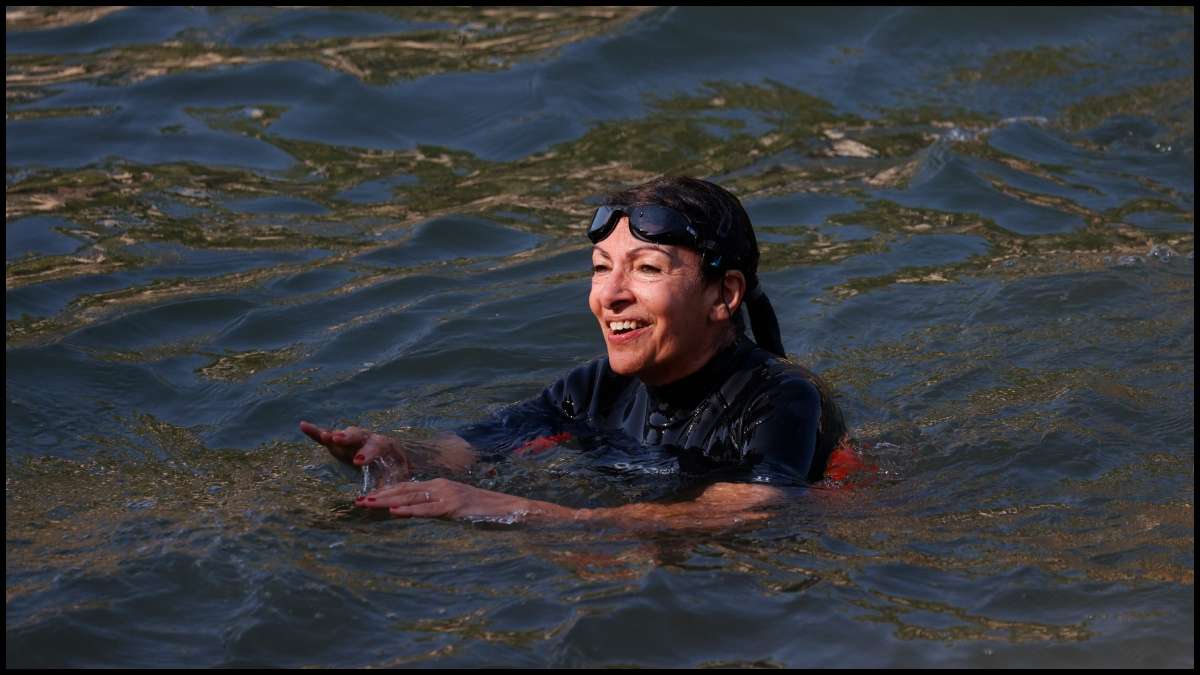
At their very best, the Olympic Games are an inspiring and uniting display of athletic achievement. Broadcast to televisions and streamed on computers in every corner of this planet, the Games give athletes and the countries they represent a truly global stage. To do what? Well, to see who is the best at moving their bodies in particular ways for specific means — which is what sports is at its core if you really think about it. And what is better at bringing people together than seeing who is the best at moving around all funny?
However, at their base operating level, the Olympics are a blight on the cities and nations that host them. To start, there's the financial burden. While the false promise of the economic benefit that being a host city provides persists, the reality of the costs has been apparent for decades, as a recent report for the Council on Foreign Relations highlights.
A 2024 University of Oxford study estimated that, since 1960, the average cost of hosting has been triple the bid price.
The 1976 Summer Olympics in Montreal came to symbolize the fiscal risks of hosting. The projected cost of $124 million was billions below the actual cost, largely due to construction delays and cost overruns for a new stadium, saddling the city’s taxpayers with some $1.5 billion in debt that took nearly three decades to pay off.
And as Michael Kimmelman wrote in The New York Times this week:
Every couple of years, when another Olympics rolls around, a familiar story is recycled: The Games are a way for host cities to fast-track infrastructure and urban-redevelopment projects. But there is surprisingly little evidence to back this story up and examples galore suggesting the reverse. Athens, which splurged on white elephant arenas in 2004 for sports that few Greeks play, stirred a rush of national pride but incurred debts that helped fuel an economic meltdown with ripple effects across Europe. Rio threw itself a giant party in 2016, then had to sell off its Olympic Village at a discount.
So dubious have the outcomes been for host cities that some experts argue New York actually won the competition to host the 2012 Summer Games because it lost out to London.
The Los Angeles 1984 Summer Games is the only time a host city has turned a profit, closing out the Games with a "$215 million operating surplus." However, that's only because L.A. was "the only city to bid for the 1984 Summer Olympics, allowing it to negotiate exceptionally favorable terms with the IOC," the city's ability to use its existing infrastructure instead of having to build a plethora of new stadiums and other facilities, as most other host cities and countries do, and skyrocketing broadcast revenue.
While making money isn't the main goal for host cities — prestige and development opportunities are certainly at the fore — the alternative is bleak, as the Council on Foreign Relations report details, "Costs spiraled to over $50 billion for the 2014 Winter Games in Sochi, $20 billion for 2016 Summer Games in Rio de Janeiro, and a reported $39 billion for the 2022 Winter Games in Beijing." That means, in a budgetary sense, the Games do not make any sense.
On the ground in those cities, it's the locals who feel the consequences. Before the 2010 Winter Games in Vancouver, houseless people were displaced en masse to "clean up" the city's image. That's horrific in its own right, but the impact was felt long after the Games were done. Jacqueline Kennelly, who studies the long-term effects of the Olympics on low-income and homeless youth for the Department of Sociology and Anthropology at Carleton University, told the CBC in 2011 that "many [houseless] youth report there are fewer social services available as governments struggle to pay off Games-related debts."
Kimmelman details further, first quoting Olympic scholar and author of What are the Olympics for?, Jules Boykoff.
“Remaking a city,” as [Boykoff]... puts it, is frequently code for “removing ‘undesirables,’ something that too often gets erased in the memory of people when they talk about legacy.” A 2007 study by the former Geneva-based Center on Housing Rights and Evictions counted more than two million people, mostly poor and homeless, displaced by Olympic host cities during the previous two decades. More than 400 families were relocated in Barcelona to make way for the Olympic Village and another 200 during the construction of ring roads. In 1996, Atlanta displaced thousands of poor and homeless residents, handing some of them one-way tickets out of state and demolishing most of Techwood Homes, one of the nation’s earlier public-housing projects.
It's a universal cruelty. In Paris, as The New York Times recently reported, "The French government has put thousands of homeless immigrants on buses and sent them out of Paris ahead of the Olympics. The immigrants said they were promised housing elsewhere, only to end up living on unfamiliar streets far from home or flagged for deportation."
It's also common for the infrastructure built for the Games, whose construction generally displaces vulnerable and low-income communities and sends cities into generational debt, to later go unused and fall into disrepair, a rather blunt analogy for the legacy of these events.
In Paris, $1.5 billion was spent to "clean up" the Seine River so it can be used for a few Olympic events. Due to the quality of the water, which had raw sewage pumped into it for decades, swimming has been banned in the river for a century. According to Wired, who reported on a protest campaign where Parisians angry with the various financial and social costs of the Games were threatening to shit in the Seine, cleaning the river isn't even a possibility. "Instead, the operation is focused on preventing new, raw sewage from entering in the first place. The city cracked down on houseboats and apartments with questionable plumbing, which had been dumping sewage straight into the Seine."
Despite their efforts, "a rainstorm last week still caused levels of E. coli to peak above the level of 1,000 E. coli per 100 milliliters considered safe for the Olympics." This, understandably, led athletes like Ireland's Daniel Wiffen to tell Wired, "Do you risk two days before your race, getting in the Seine and getting ill the day before your race?"
To help assuage their worries in a hammy show of what was supposed to prove progress, the mayor of Paris took a plunge into the Seine. This analogy is excruciatingly direct — a government official bleeding money and swimming in shit, assuring the public that everything will be just fine.

Course of action
Rank: 🥉
Mood: 🛣️
The Instagram bio of California Skateparks, which designed and built the street and park courses for the Paris 2024 Olympic Games, reads "The World's Most Recognized Skatepark Design & Build Firm." What does it mean to be the "most recognized" at something? Is that good? What exactly are they claiming here? There are a number of ways I could imagine being "most recognized" for something would, in fact, be bad. It's a vague enough superlative to mean a big, sweeping nothing.
It reminds me, in a strictly semantic sense, of how the IDF declares itself the "World's Most Moral Army." That's despite unrelenting, generation-spanning evidence and multiple ICJ rulings to the contrary. It's marketing, lazy and, in this case, perverse. The words are used as a taunt or in hopes they fill some empty space in others' limited understanding and come to resemble truth. Reality makes a person wonder how Israeli athletes were even invited to compete in Paris, considering the genocide their rogue state is actively committing in Palestine, and how some Israeli athletes actively serve in various positions in the IDF, including as spokespersons. Their flag-bearer has signed missiles destined for slaughter in Gaza. All the while, waving a Palestinian flag is a cause for police concern in Paris' streets.
Thankfully, California Skateparks' only crimes are against good taste. Last week, they revealed the street and park course designs that have since gone up in Place de la Concorde, and they look... fine, I guess. Aesthetically drab and certainly not something for plebs, these are grand ho-hum stages for stunting at the highest level. According to California Skateparks' Instagram, there is a methodology behind their designs.
After completing the final Olympic Qualifying Series event course in Budapest, the @caskateparks crew headed to The City Of Light to install the @paris2024 @olympics courses. More than two years in planning, the Street and Park courses represent a logical progression from the events this year’s Olympians rode to qualify for Paris. The stage is set on the Place de La Concorde for the Street (July 27) and Park (August 6) competitions, and the setting couldn’t be more spectacular.
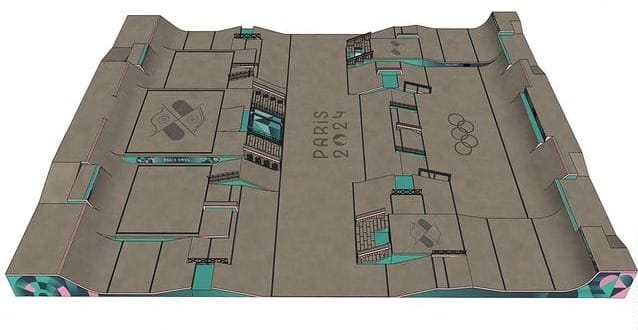
To my eye, these courses stand in stark contrast in design philosophies. On the street side, it looks like they've jammed every obstacle possible into the room available to an almost claustrophobic degree. Well, to clarify, those obstacles are mostly down rails or ledges, of which there looks to be 14. How many Caballerial-lipslides will we see on the course this weekend? I'd guess the number will reach into the hundreds.
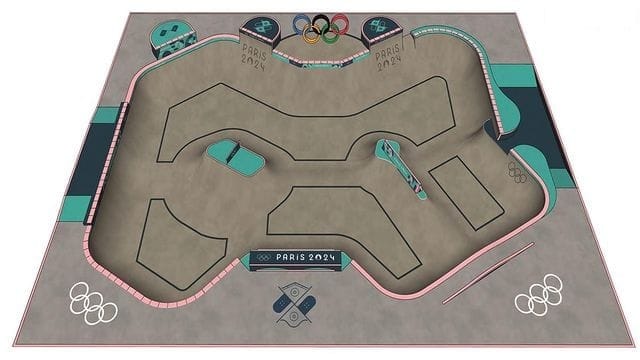
On the park side, we get a very different approach. It's a spacious, open course that I imagine will require a whole lot of excess pumping to get around. There look to be a couple of unique obstacles in those fin-rails mounted in the centrepiece tabletops, but beyond that, it's a pretty straightforward design as far as these tend to go.
It would be interesting to see how California Skateparks charted the evolution of the qualifying course designs up to these, whether the athletes recognized those consistent design threads, and if they had an impact. Until then, if someone does a fly-out through the rings, that would be appreciated.

Olympic fever
Rank: 🏅
Mood: 🌡️🥵
As the Paris 2024 Olympic Games loomed, content was and continues to be created for our little corner of the world. The brands are doing it, media in and outside the bubble are doing it, and hell, I'm doing it right now.
ASICS put out a nice little social asset for their rider, Kieran Woolley, who talks about the challenges of juggling street skating and filming for various projects with training for the Games. Nike featured Alexis Sablone getting into the inspiration for the design of the 2024 Nike SB Skateboarding Federation Kits, and 'sletter friend Farran Golding talked to Sablone about all that and more for G.Q.
The Guardian highlighted Chloe Covell, Sky Brown, and Andy Mcdonald; Men's Health asked Jagger Eaton how he's handling things; Teen Vogue covered Rayssa Leal and her environmental activism or, at least, her station as an International Olympic Committee Sustainability Ambassador; and NBC News did a hit on Dr. Neftalie Williams going to Paris as an ambassador of skateboarding for the U.S. State Department.
Skatefolio also put together a fun project called "Meet the Olympians," which creates a profile for each athlete competing in Paris and compiles their street footage, if available. "For easy reference, we ranked everyone's footage from 'nonexistent' to 'legendary' based on their video part output." (Shoutout to Josh Katz for sending that over.)

Even Tony Hawk created some bespoke Olympic content by turning Tom Schaar PRO for Birdhouse Skateboarders as the skateboard park contender headed to Paris.
It's not often that skateboarding has a centralizing event where so many of us are tuned in (with interest or disgust), and especially like this, where the mainstream media and viewership are right there with us.
Put your hand to your forehead. That warmth, the clammy flesh? That's Olympic fever. We've all got it, and unfortunately, it's terminal.

Olympic skateboarding primer: part 2
Rank: 🥈
Mood: 🥣
For a non-skateboarding audience, especially on the scale of those watching the Olympics, I wonder which skateboarding event is more entertaining. Skateboard street, with its format of run attempts followed by best trick attempts, can often become a nail-biter. If the competition is close, those final few tricks can mean everything and build up to genuinely dramatic moments that feel big.
In skateboard park, though, you get to see people fly through the fucking sky. They're not getting Lincoln Ueda-level hangtime, but when you've got athletes like Pedro Barros and Arisa Trew, they'll be up there. The format of three runs, with the best-scored run counting, is a bit tired and can often declare a winner long before the event finished, but it's still a good time.
Speaking of, let's get into skateboard park, which, if you didn't know, takes place in a bowl.

1. Kokona Hiraki (JPN)
2. Arisa Trew (AUS)
3. Sakura Yosozumi (JPN)
4. Sky Brown (GBR)
5. Hinano Kusaki (JPN)
6. Raicca Ventura (BRA)
7. Bryce Wettstein (USA)
8. Ruby Trew (AUS)
9. Dora Varella (BRA)
10. Ruby Lilley (USA)
11. Isadora Pacheco (BRA)
12. Minna Stess (USA)
13. Naia Laso (ESP)
14. Heili Sirvio (FIN)
15. Lilly Stoephasius (GER)
16. Nana Taboulet (FRA)
17. Lola Tambling (GBR)
18. Fay De Fazio Ebert (CAN)
19. Emilie Alexandre (FRA)
20. Julia Benedetti (ESP)
21. Haohao Zheng (CHN)
22. Aya Asaqas (MAR)
Much like women's street, the competitors in women's park are progressing at breakneck speed. Kokona Hiraki took home silver in Tokyo and seems poised to snatch gold from her teammate and defending champion, Sakura Yosozumi, in Paris. Arisa Trew has had a hell of a year. From competitive success to being the first woman to land a 900, Trew is... the truth.
That said, there are ringers up and down the field. Someone like Fay De Fazio Ebert, who I wrote about for the Toronto Star last week, has a steep hill to climb, but at just 14 years old and with the wind at her back, a top-10 finish or better isn't out of the question. Names like Minna Stess and Tokyo bronze-medalist Sky Brown are also coming into their own and shouldn't be counted out of a podium position, either.
🥇 Arisa Trew (AUS)
🥈 Kokona Hiraki (JPN)
🥉 Bryce Wettstein (USA)
For my money, gold is Trew's to lose, and oddsmakers agree. (What a world we live in where we can bet money on children skateboarding.) Hiraki or Yosozumi are also primed to take it, but I see the former landing silver and, in a bit of a wildcard choice, Bryce Wettstein taking bronze. The American is a left-field selection, but she's looked good as of late and has such a different bag of tricks that if she can stay on the board, she'll stand out to the judges.
Special trick prediction: Hiraki backside-overcrooks one of the tabletop rails.
Special performance prediction: Ruby Trew (no relation to Arisa), cracks the top 5.
More Ruby. This time, Lilley. Did you see her Monster Energy video part? She's got the potential to shock people.

1. Tate Carew (USA)
2. Keegan Palmer (AUS)
3. Gavin Bottger (USA)
4. Tom Schaar (USA)
5. Augusto Akio (BRA)
6. Kieran Wooley (AUS)
7. Luigi Cini (BRA)
8. Pedro Barros (BRA)
9. Danny Leon (ESP)
10. Viktor Solmunde (DEN)
11. Keefer Wilson (AUS)
12. Alex Sorgente (ITA)
13. Hampus Winberg (SWE)
14. Vincent Matheron (FRA)
15. Steven Pineiro (PUR)
16. Yuro Nagahara (JPN)
17. Alessandro Mazzara (ITA)
18. Thomas Augusto (POR)
19. Alain Kortabitarte (ESP)
20. Andrew Macdonald (GBR)
21. Tyler Edtmayer (GER)
22. Dallas Oberholzer (RSA)
I'm going to be honest with you: I haven't been paying too much attention to the men's park qualifying events, which means the following sections will be entirely vibes-based. Tate Carew? More like Tate Ca-Who? He's clearly good if he's coming into Paris ranked at the top of the heap, but I can't say I even know what he looks like. And everyone on this list is otherworldly talented, so how do you decide, anyway? Thankfully, that's where the vibes come in.
You can feel the chip on Baby Bottger's shoulder. This supergrom had been gestating in the lab for years and is now ready to show the world that he's more than just another Woodwards kid. That's a vibe. Defending champ Keegan Palmer is a guy whose whole life is simply this, and now he's arrived, once more, at the inflection point. Definite vibe. Tom "PRO AF" Schaar appears to be taking this seriously now, which is a scary thought (vibration?), and Pedro Barros is Pedro Barros — a human cannonball. A wild animal who feeds on the sky. A consummate vibe.
Side note: Out of all the events and divisions, I think this is where we will see the most mind-gobbling maneuvers. That's a vibes-approved divination.
🥇 Tom Schaar (USA)
🥈 Gavin Bottger (USA)
🥉 Keegan Palmer (AUS)
This came to me in a vision, what can I say. Come August 7, I expect a flood of comments saying something along the lines of Lisan al-Gaib.
Special trick prediction: Schaar lands a 900 on concrete.
Special performance prediction: Andrew Macdonald finishes in the top 15.
Vincent Matheron is a guy to keep an eye on, as that home-country advantage may be the boost he needs. One of Kieran Woolley's greatest strengths is cramming an incredible amount of tricks into his runs. This course seems like it might make that a bit difficult, but if he can work it, that could be the edge he needs to make the podium.
Alright, that's it. Enjoy watching the absolute zenith of athletics (including breakdancing). Or not, it's up to you. If we still exist by then, we can do it all again for the Los Angeles 2028 games.

Something to consider: Donating to Rajab's GoFundMe.
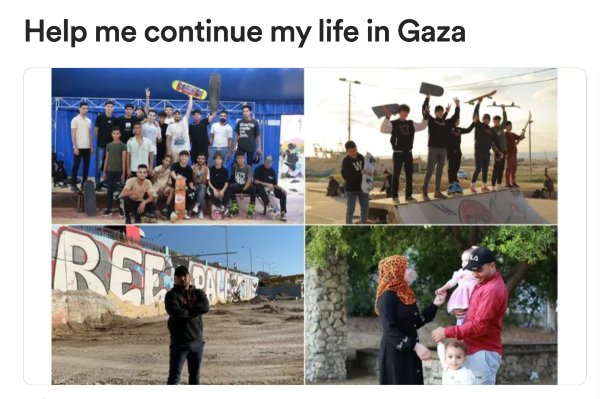
Good thing: New Vent City.
Another good thing:
That's right, another good thing:
The good things keep coming:
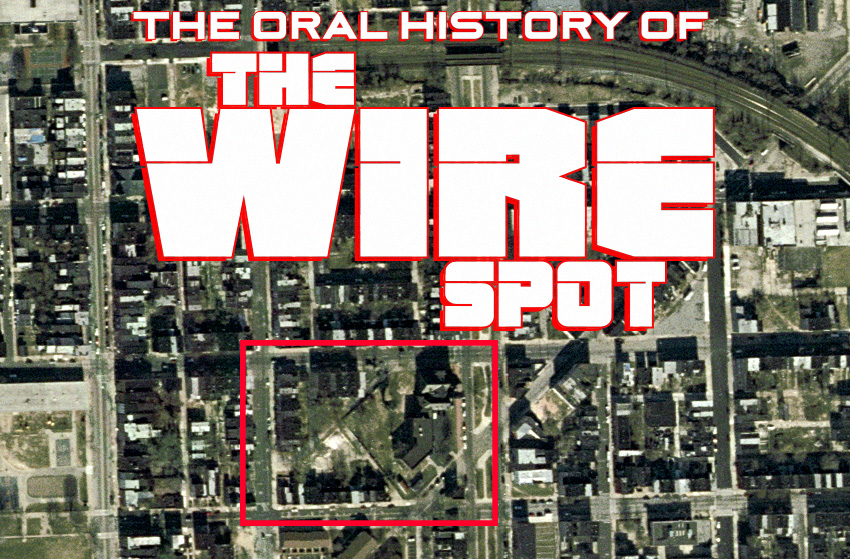
An academic thing: Professor Sander Hölsgens talks about the positive impacts of skateboarding's inclusion as an Olympic sport, particularly with cities and how municipalities view the use of public space.

A bad lighting thing:
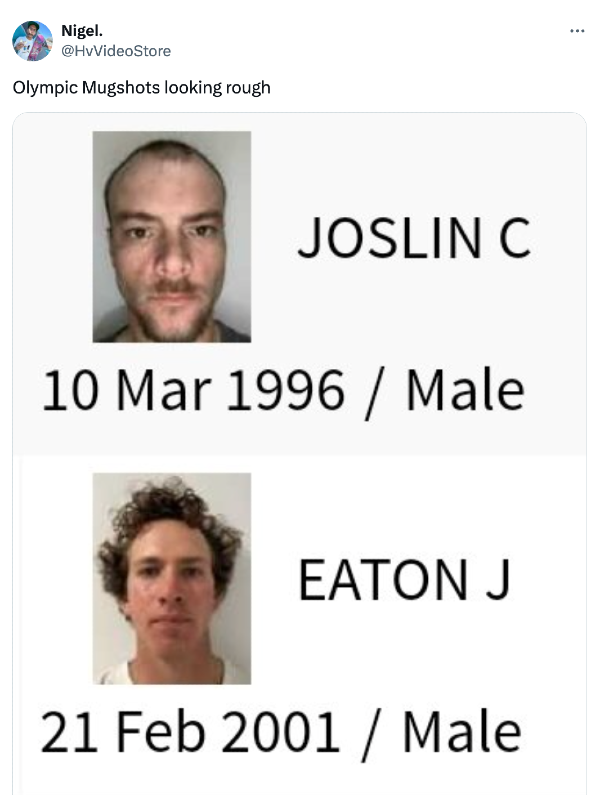
A The Bunt Jam thing: Shout out to Steven for getting redemption on his half-court shot from last year.
Speaking of last year...
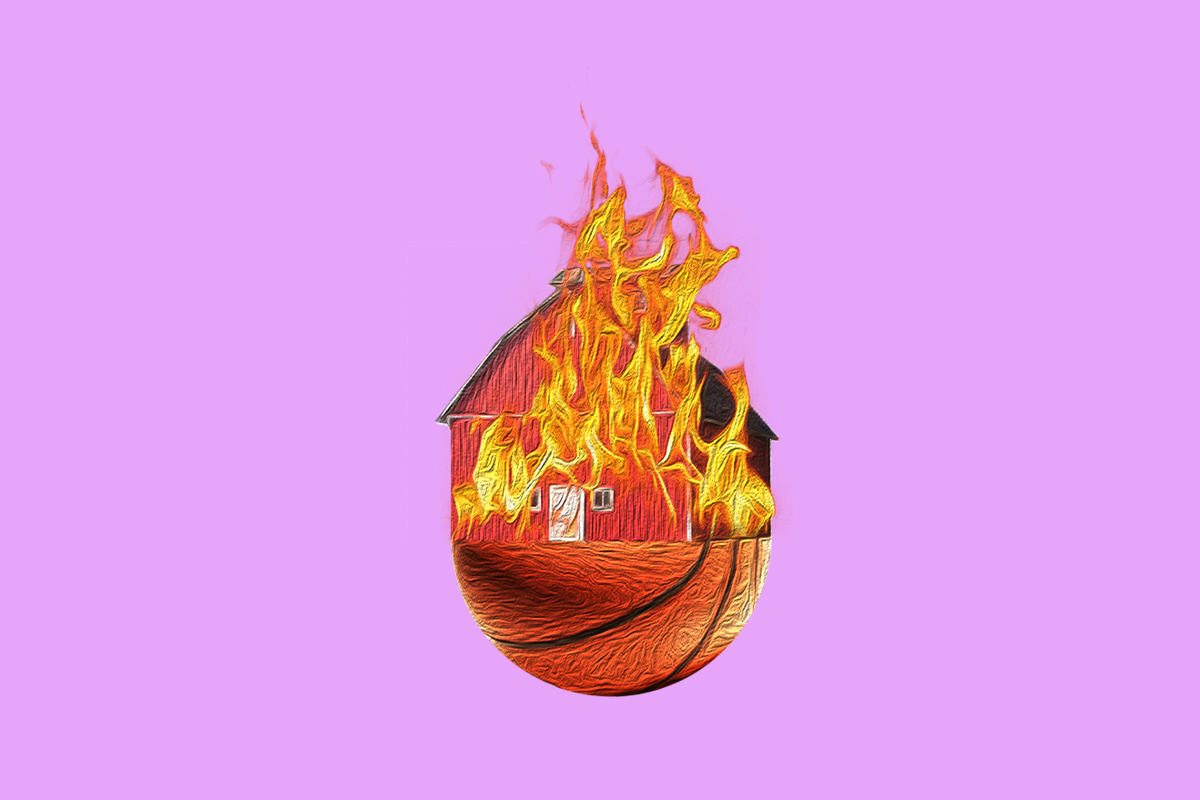
Until next week… gold, silver, bronze — who needs 'em. You're all winners in my book.


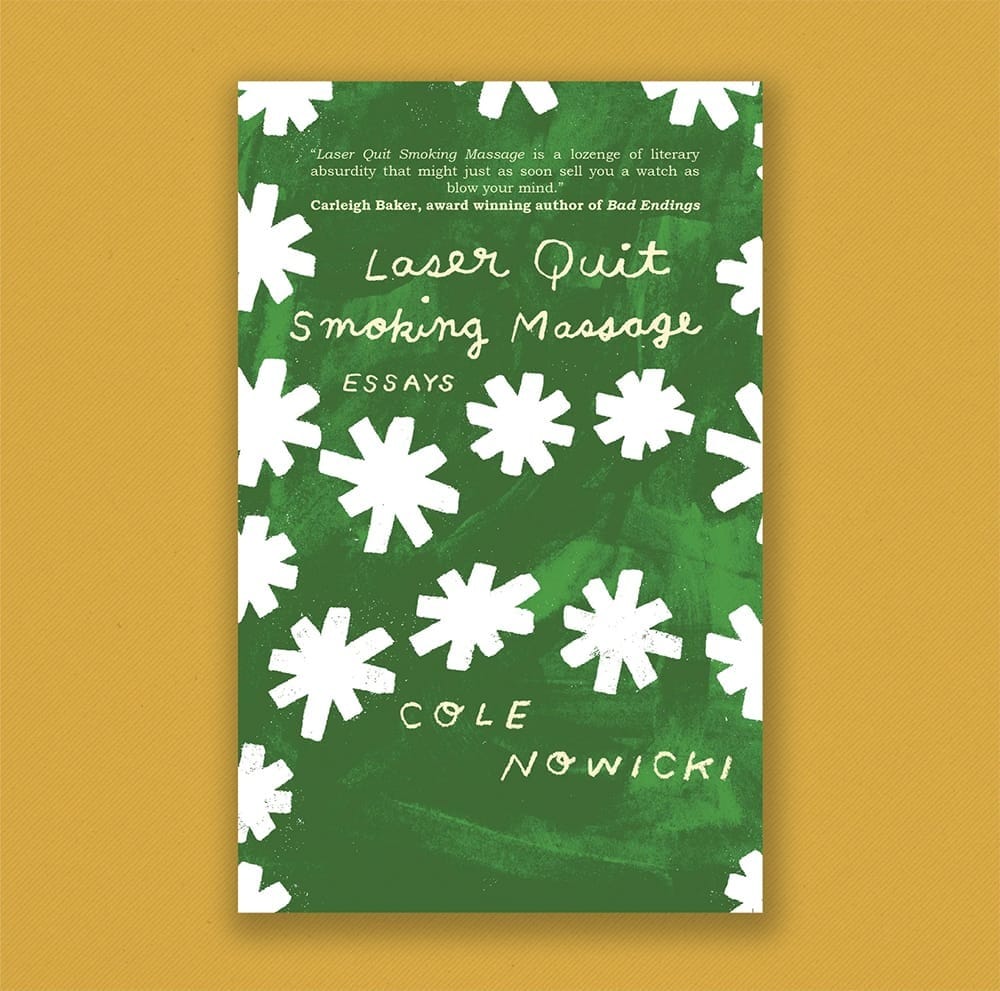
Laser Quit Smoking Massage
NEWEST PRESS, available April 1, 2024
--------------------------------
My new collection of essays is available now. I think you might like it. The Edmonton Journal thinks it's a "local book set to make a mark in 2024." The CBC called it "quirky yet insightful." lol.
Book cover by Hiller Goodspeed.
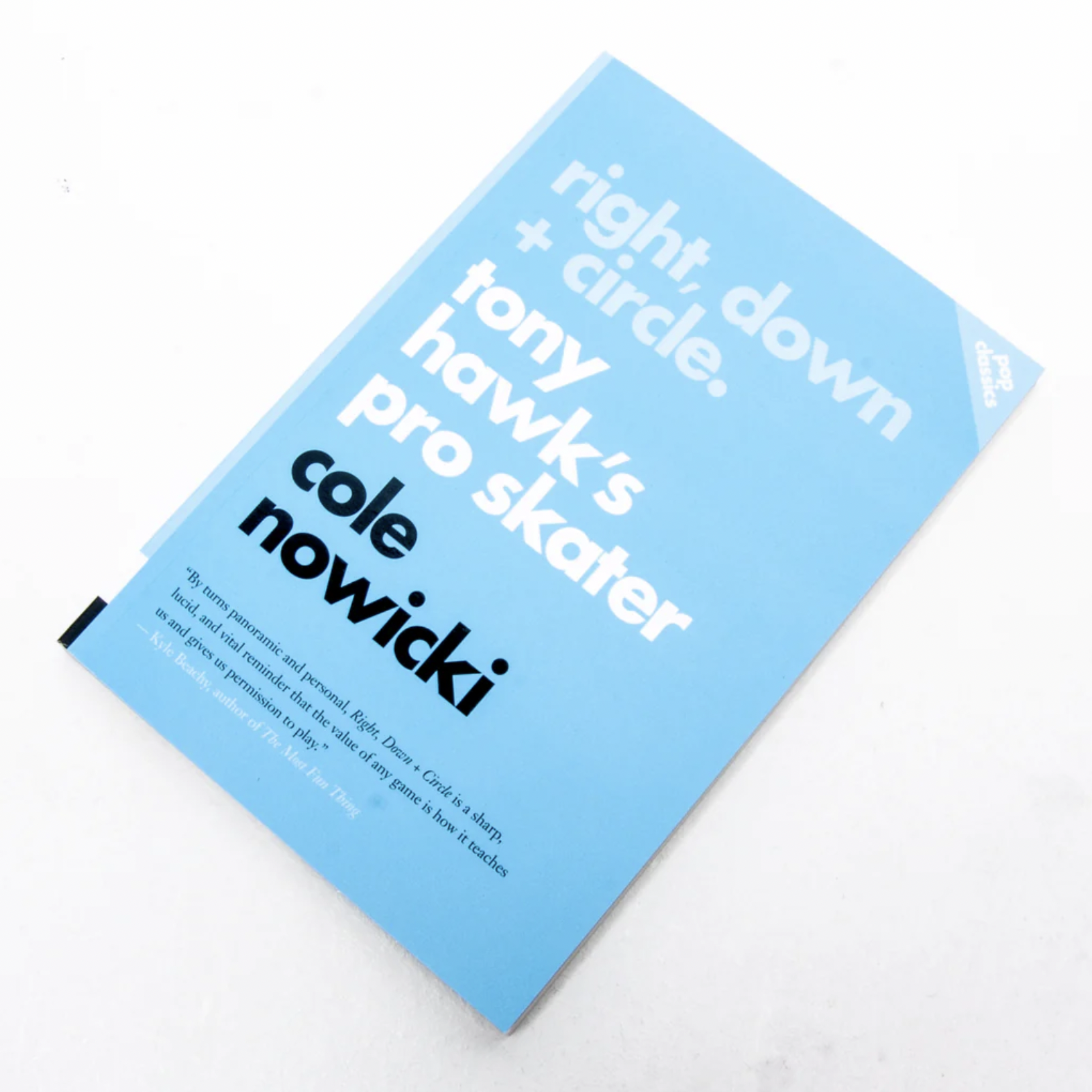
Right, Down + Circle
ECW PRESS
--------------------------------
I wrote a book about the history and cultural impact of Tony Hawk’s Pro Skater that you can find at your local bookshop or order online now. I think you might like this one, too.
Here’s what Michael Christie, Giller Prize-nominated author of the novels Greenwood and If I Fall, If I Die, had to say about the thing.
“With incisive and heartfelt writing, Cole Nowicki unlocks the source code of the massively influential cultural phenomenon that is Tony Hawk’s Pro Skater, and finds wonderful Easter-eggs of meaning within. Even non-skaters will be wowed by this examination of youth, community, risk, and authenticity and gain a new appreciation of skateboarding’s massive influence upon our larger culture. This is my new favorite book about skateboarding, which isn’t really about skateboarding — it’s about everything.”
Photo via The Palomino.








